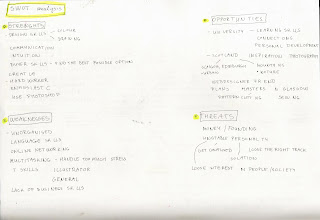The aim of this module is to make it easier for us to set up our own business once we finished our studies. We use a toolkit by NESTA and we have workshops every Friday to discuss ideas. I found this module extremely useful so far although it isn't my favorite thing to think about business. This toolkit meant to be creative and I think it is as much as possible.
NESTA Creative Enterprise Toolkit
Notes:
What is it that I do?
I do printed textiles.
Why should my customers care?
Because I try to capture beauty in my work and influence customers’ emotions in a good way, which can affect their mood, maybe even their well-being.
“Customer demand is like putting petrol in a car. You may be going along, even at speed, but unless you keep refueling you’ll grind to a halt at some point.”
- Talk about the benefits the creation will bring, rather than describing its features and functions.
- Customers always have to be in the center of the business idea. What benefits my product has to offer for them? Check the benefits through customer satisfaction surveys.
- Innovation is essential to keep my customers interested in my inventions. Communicate the vision of my business clearly and consistently. Research the market if there’s a need for what I’m offering and if not I have to create demand for the product.
How to protect intellectual property?
- - Make a list of all my creative assets.
- - Register them at the UK Intellectual Property Office website.
- - Have written confidentiality agreements with manufacturers and clients.
- - Record the making/designing process with dates (including emails).
- - Every copy of my work has to be marked with © (Name of owner, Date Country).
- - Packaging has to have ® and design rights number on it.
- - Don’t give rights to clients without asking for external advice, and charge an assignment fee.
- - Keep an eye on advertised new trade trademarks, see if any infringes mine.
- - Ask a lawyer if I need to take action.
- - More advice: Own-it – Intellectual property Advice for Creative Businesses.
Values Chart:
It’s crucial to keep reminding myself what is important for me, what values inspire me and keep me going so I won’t get lost in the business world.
Find the balance between passions, talents and economic drive to create a sustainable business.
Mission Statement:
- - Why my business exists and its future intentions?
- - Motivational, realistic, 3-4 sentences long.
Evidence Modelling:
Visualising my business in details:
What does it enhance?
What does it replace/make less desirable?
What does it revive?
What might be the backlash?
Could an idea become so successful it actually ends up having a negative effect? For example, if a car-sharing service is so well designed it actually tempts people off public transport and into cars, increasing congestion, then a successful idea actually ends up having a negative effect.
SWOT analysis:
I took more of a personal approach on this task, simple because I found it more useful for now. It should be more about the market, my customers, and my team but at this stage I can’t think about those. Well, I've tried to be brutally honest since the aim of this exercise is to turn our negative qualities into positive.
Fake Evidence:
Visualise my business in a context! Communicate my idea! Where would I see my product to be featured? What’s my biggest dream for my company?
At this point I don’t have a finished idea about my business, not even about my own style. However I find it very useful to think about it and learning this technique also allows me to repeat it any time I want to.
I had a look at several websites and magazines to find the perfect one to be featured in.
My absolute favorite:
i-D is a British magazine dedicated to fashion, music, art and youth culture. i-D was founded by designer and former Vogue art director Terry Jones in 1980. The first issue was published in the form of a hand-stapled fanzine with text produced on a typewriter. Over the years the magazine evolved into a mature glossy but it has kept street style and youth central to every issue.
And who else could wear my dress in case I have to 'Think BIG' than Björk. It would be amazing :)
But to get the founding for my own business I would be happy to work for Kenzo, Etro or Missoni, just too keep it realistic :)
Research to find the material for my Fake Evidence:
I had a look at Kate Fletcher's blog, Notcouture, and Treehugger.
I found other interesting websites:
And also:
http://www.ecofashionworld.com/

















